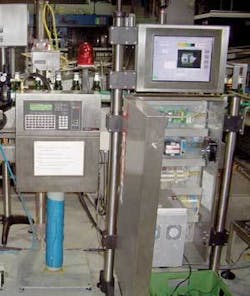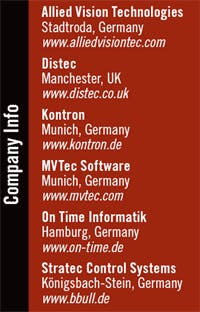Tracking system eases beverage inspection
Vision system with FireWire cameras, custom LEDs, and control system inspects multiple label locations.
By Georg Kraus
At 50,000 beverage bottles per hour, inspecting the labels, caps, and fill levels is one of the most demanding applications facing a machine-vision system. High-speed manufacturing lines require high-speed image acquisition, which places additional-sometimes excessive-burdens on image-processing systems.
This was the situation the Hite bottling plant in Jeon-Ju, Korea, faced when looking for an automated inspection solution for two beer-bottling lines. The company needed to inspect front, neck, and back labels for different bottle sizes and different product lines. Hite turned to bottling-machine-vision specialist Stratec Control Systems for help.
FIGURE 1. Stratec BV 3000W universal image-processing system has been installed in several bottling plants to inspect labels and bottles. It comprises FireWire cameras, high-brightness LED flashlamps, and image-processing software. An image-processing platform handles the I/O in conjunction with a dedicated tracking-controller unit for real-time communications with high-speed PLCs common to bottling lines.
Stratec developed a system based on its BV 3000W universal image-processing system, composed of three Marlin series FireWire cameras from Allied Vision Technologies, Stratec high-brightness LED flashlamps, MVTec Halcon image-processing software, and an image-processing platform that uses a Kontron ETX 3.0 computer-on-module board attached to a Stratec proprietary motherboard to handle the I/O in conjunction with a dedicated tracking-controller unit for real-time communications with high-speed PLCs common to bottling lines (see Fig. 1).
IEEE 1394 vs. USB
To meet the customer’s throughput needs, Stratec selected each component to maximize data bandwidth, reduce image-processing requirements, and separate real-time operations from non-real-time operations. Bottles enter the inspection workcell from upstream conveyors/accumulators, passing in front of a camera one at a time. After the inspection is completed, the bottles that pass inspection proceed downstream toward packaging equipment; rejected bottles are determined before packaging by downstream systems.
To ensure that downstream systems have the reject data based on inspection results in time to act, the system needs nearly real-time communication between the camera and various image-processing boards and real-time deterministic communication between the vision system and the downstream systems. Stratec accomplished this by splitting the Windows-based vision-processing platform from the downstream communication electronics.
The system uses a 640 × 480-pixel, F033B Marlin-series FireWire camera from Allied Vision Technologies. In addition to offering true partial readout capabilities from a CCD sensor to boost frame rates, the Marlin series has a built-in IEEE 1394 output. A FireWire interface imposes a lower CPU load at high frame rates compared to USB, so this was a high-performance, low-cost solution. In a similar way, MVTec Halcon image-processing software offers a universal frame-grabber interface, allowing the flexibility to use any available and supported frame-grabber/camera combination should the application require a change in hardware. Halcon also runs multiple image-processing threads from separate cameras in parallel, which increases throughput (see Fig. 2).
High-speed inspection puts increasing demands on illumination sources because cameras operating at faster shutter speeds (this system operates at 1/2500 or 1/5000 s) require more light to generate adequate images. For lighting, project-specific, self-designed LED flashes based on high-brightness LEDs are used. For the label-control portion of the Hite bottling-inspection application, intense light surrounding the bottle was needed, leading to a combination of six LED arrays positioned about key points around the bottle (see Fig. 3).
FIGURE 3. FireWire camera assembly containing custom-designed high-brightness LEDs inspects labels.
Inspecting the SKU regions on each label posed a challenge with regard to the light source. Since the SKU region is highly reflective, direct illumination was combined with diffuse illumination. The flash and the cameras are built into sealed, industrial-grade cases.
Real and Nearly Real Time
For image processing, Stratec uses an industrial PC kit mounted on a motherboard, plus an external microcontroller-based tracking box. The ETX computer-on-module configuration is used because the small-form-factor board hosts a Pentium IV 1.8-GHz processor, which can run Windows in an isolated environment. In addition, the ETX compact size was important.
Kontron’s ETX 3.0 board offers four connectors: PCI/USB/audio; ISA; VGA, LVDS, and TV; and PS/2, IRDA, and IDE for peripherals and storage. The PCI connection ties into the Stratec motherboard, the VGA connector goes to a Distec TSC-10/RSA touch screen for operator interaction, and the IDE connector goes to a 20-Gbyte hard drive for local storage of images and data. The hard drive also holds the Halcon image-processing library, which is loaded into 1 Gbyte of RAM at startup, and Stratec’s Image-3000 front-end software. Additionally, the separate motherboard provides more I/O for up to four FireWire cameras, USB and a CAN bus interfaces, and an Ethernet connection for remote system access and software upgrades via the Internet.
The CAN bus connects the motherboard to the external microcontroller-based tracking unit, running real-time firmware, which is low-level software written in “C”. Because the Windows operating system is used on the ETX board, there is no guarantee for true real-time processing. Therefore the Windows PC works together with the tracking controller, which handles all real-time communications. The Windows software communicates with this unit via the CAN bus using PDO (process data objects) messages to exchange time-critical information and SDO (service data objects) messages for parameter information.
FIGURE 4. Inspection-system cabinet with touch screen runs a custom user interface showing parameters, status, and errors. Industrial PC and tracking module are inside the enclosure. An inkjet at left applies the “best before” date coding.
The Image 3000 user interface with parameters, status, and errors runs on the Windows PC. Depending on the complexity of the overall process interface, either a small microcontroller-based unit for the tracking controller or a second PC blade with the RTOS-32 real-time operating system from On Time Informatik is used (see Fig. 4).
Boosting Bottle Inspection
The tracker controller receives a signal from an external photoelectric cell located near the bottle stream. This signal causes the tracker to generate a trigger signal for the camera system. The tracker can use a variety of external signals as trigger signals, including encoders and conveyor controls.
At the same time, the tracker sends a signal across the CAN bus to inform the PC that a new object was triggered. When the ETX image-processing system has finished the inspection routines, it sends the result back to the tracker, using the same CAN bus. The tracker accounts for the position of each object and triggers the downstream rejector. Also, it communicates with the customer PLC via Profibus or TCP/IP, depending on the plant’s infrastructure.
There are several messages sent between the tracker and the Image-3000 software. Delayed processing on the Windows side will not affect the overall real-time performance. Using a set of message mailboxes, Windows can pause and delay the processing for a short time without loosing synchronization. To ensure throughput, the PC processing power is higher than required at the highest line capacity.
The system has a three-layer structure-the deepest layer is the image grabbing task, then the image-processing and process interfacing layer, and at the top is the GUI/results layer. Each layer runs its own thread set to a specific priority. The communication between the layers is uncoupled with synchronization objects. Each camera channel has its own set of threads, except for the GUI layer, which is common for all. Again, Halcon’s parallel processing capability makes this high level of parallelism possible.
Written in the Borland-Delphi environment because of the compiler speed and familiarity, the Image-3000 software provides an application-specific interface for the Stratec BV 3000W beverage-inspection system. Users can select specific regions of interest with the camera’s field of view and associate different image-processing routines to each area, such as label position, OCR for lot code readings, presence/absence to check for property cap alignment, and fill levels. All inspection data and pictures of product that failed inspection can be stored on the hard drive and optionally be accessed and stored in a SQL database via Ethernet from any remote location with proper security access.
Georg Kraus is technical manager, Stratec Control Systems, Königsbach-Stein, Germany; www.bbull.de.
Features, advantages, benefits
At Diageo Baileys in Ireland, Stratec installed a one-camera system that performs a double-segment fill-level inspection (black/white content) and a complex cap inspection. On the same 10,000-bottle-per-hour manufacturing line, the system also performs a three-camera label inspection for front label, back label, and cap label. The inspection system is mounted near the conveyor.
At the Hite brewery in Korea, Stratec equipped two beer-bottle lines with label-inspection systems for front, back, and neck label. These lines run at approximately 50,000 bottles-per-hour, and the inspection system is mounted in the labeler (in the machine). Other installations include Pedigreed, UK (one-camera label inspection system for cans); Soest, Germany (OCR reading for Coca Cola); Neuss, Germany (inspecting fill level and caps on cooking-oil bottles for Nestlé); and Roncadin, Germany (label inspection on ice containers).





